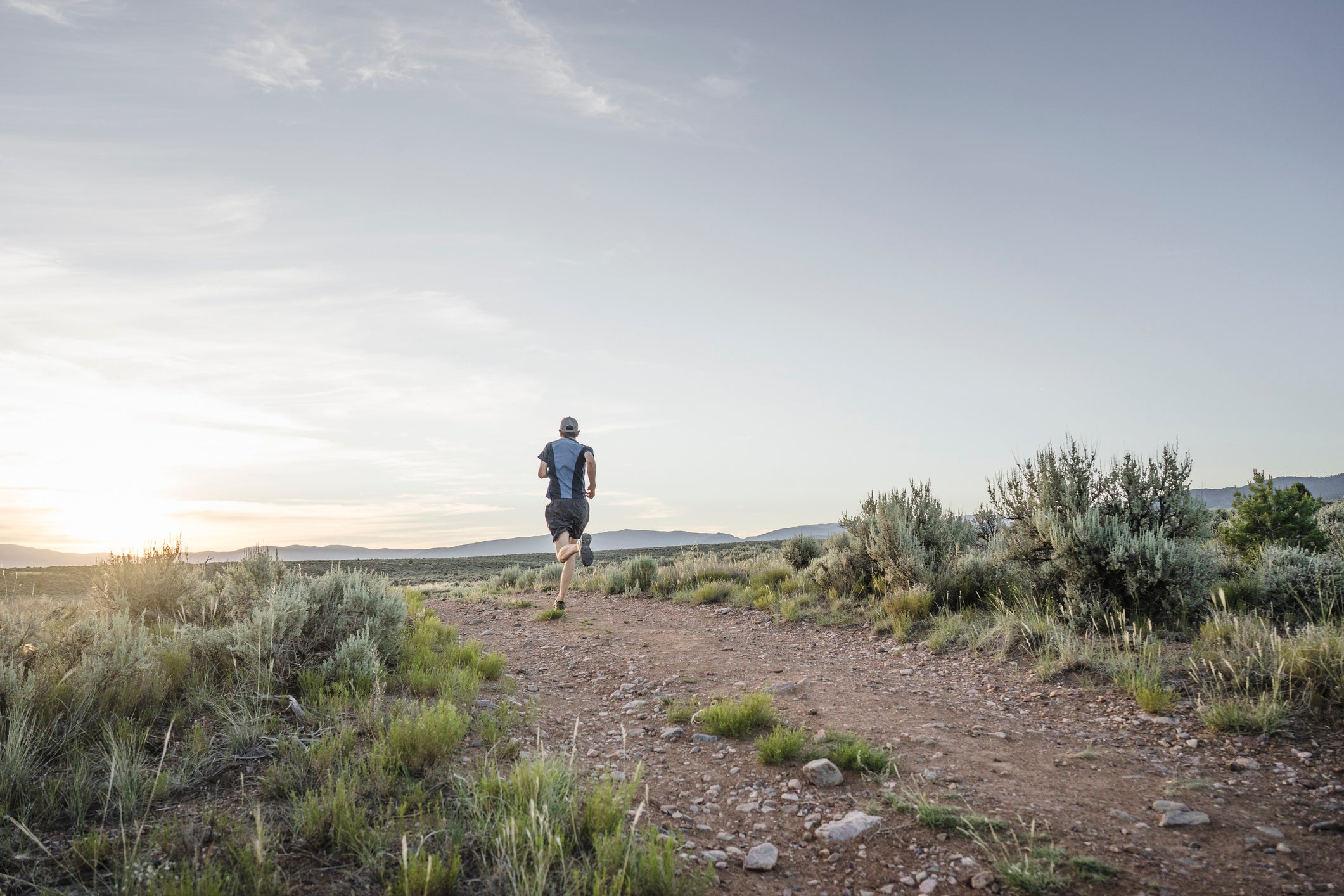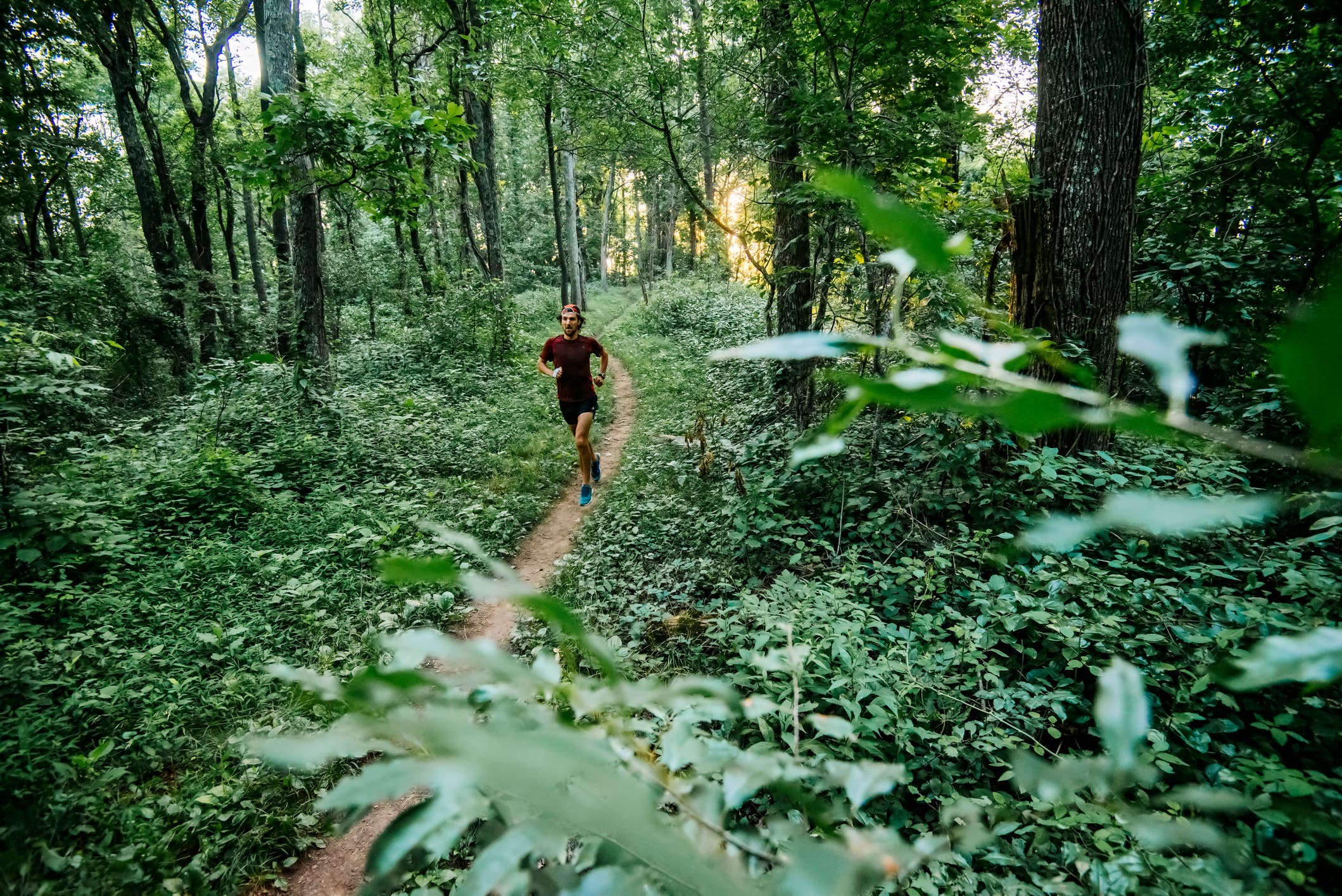How To Run Your First 50 Miler

Rear view shot of single man trail running through sagebrush desert, Taos, New Mexico, USA
If you have been curious about taking the leap from 26.2 or 31 miles (50K) to 50 miles, figuring out how to train for your first 50-miler may seem daunting.
But don’t stress—the primary goal in your first 50-miler should simply be to finish the race. With the proper build up, mental attitude and persistence, it’s an achievable goal for most athletes.
RELATED READING:
Train For Your First Ultra Over 50k
How Much Mileage Should You Run?
Getting Started
To finish your first 50-miler, begin the training process early. “Allow a four- to six-month build-up if you’re starting to run again after a layoff,” says Scott Drum, Ph.D., Director of the High Altitude Performance Lab in Gunnison, Colorado, “or about three months if you have been training consistently for the previous three months.”
Since most 50-mile ultramarathons are on trails and may involve rough terrain, altitude and hill, it’s important to select a race that suits your abilities and usual training environment. A flatlander who lives at sea level, for instance, should avoid graduate-level 50-milers like Colorado’s high-country San Juan Solstice 50 or Devil’s Backbone 50 in Montana’s Gallatin Range (two of my faves). (See sidebar for some good first-timer options.)
Turn Up the Volume
Volume is simply how much training you are doing overall, week to week, measured in time or distance. For simplicity’s sake, we’ll use distance. Since 50 miles in one day may be more than you currently run in a week, it will take more training volume to achieve your goal.
Whereas an average beginner marathon-training program varies weekly from 15 to 45 miles per week, a weekly volume of 50 to 60 miles will allow most runners to experience a great first 50. Assuming that you have run a marathon before, add 10 to 15 percent to each week’s total volume by increasing the length of every run if possible. Increase mileage for three weeks, and recover during a fourth week by dropping your mileage down into the same range as week one.
It’s All About the Long Run
Just as long runs are the backbone of any marathon-training plan, so it is when training for a 50-miler. Says professional ultrarunner Sean Meissner, “The weekly long run is the key to training for your first 50. As long as you’re progressively increasing the distance, do not worry about speed.”
In your first 50, you could be running between seven and 15 hours on race day. To build your endurance, long runs should be performed once a week or every 10 days, depending on your run history and ability to recover. Work to extend your longest long run to around 30 miles. Don’t be afraid to walk—in fact, practice it—during your long runs, because you will most likely walk in the race.
The 10-percent-per-week rule for increasing volume and distance is one I both love and hate. It’s a good guideline for most folks, but does not apply to everyone. It absolutely does not apply to talented or accomplished athletes in other sports who are running their first 50-miler. For the rest of us, it is a great starting point, and a safe bet.
Be Specific
As your training progresses, consider specificity, which means your training should be relevant and appropriate for your race course. If you are lucky enough to live near the goal race, run sections of it whenever possible.
If not, try to run trails or terrain that resemble the race course. If the race is fast, smooth singletrack, find a dirt bike path to run. If the race includes monster climbs, hit your local mountain trails or find something that challenges those same muscles and kinetic mechanics.
Speed Thrills
If a busy schedule that includes families and work makes you pinched for time, run hard. Studies show that a small amount of speed work can have a profound effect on your fitness.
While overall training emphasis should be on your long run, volume and consistency, everyone can benefit from speed work. My favorite way to incorporate speed is doing a 20-minute tempo run, which is run about 25 to 30 seconds per mile slower than current 5K race pace.
For runners who just can’t tolerate specific paces and track work, I prescribe fartleks. The word fartlek is Swedish for “speed play” and entails freestyle intervals, however long or short you feel like running them. For example, sprint to that rock a quarter-mile away, get your breath back, then power up the ensuing half-mile hill, recover and repeat over a period of 15 to 20 minutes.
Sneaking tempo runs and/or fartleks into each week will make a difference. Think of it as working the top end of your fitness. When running intervals, you are generally running anaerobically (without oxygen), which makes the body more efficient at consuming oxygen. This means your slower race pace will feel easier. Speed work also resets your brain’s concept of hard, improves economy and increases your muscular force, all of which has a trickle-down effect on slower-paced running. Don’t add speed and increase volume in the same week. Adding both is a recipe for injury.

Keep Your Head
The mental component of running your first 50-miler cannot be understated. Says the 2009 Ultrarunner of the Year and 2010 Western States 100 Champ, Geoff Roes, “If your body hasn’t raced 50 miles before, it’s not going to want to do it, so the key is to make sure you want it.”
Sticking to your training program and consistently doing weekly long runs is the best way to convince your mind you can and will run 50 miles. It also helps to expect the inevitable. The longer the run, the more chances you have to feel bad. As long as you know a low point will come, it’s easier to deal with mentally and not let it knock you off track.
Essential Hydration and Nutrition Tips
Practice race-day nutrition during every training long run.
- Drink often, aiming for 14 to 28 ounces per hours.
- Set a watch alarm to remind you to eat a gel every 20 to 30 minutes—yes, that’s 200 to 300 calories per hour. That’s what it takes!
- Eat early and often. Stay on top of it. If you bottom out early, it’s a long and hard road back from Bonktown.
- You will need to replenish electrolytes (pill, tablet or liquid) so find a product that works for you.
- Don’t assume the gels and food the race provides will work for you; test them in training.
Get on the Program
| Week | Mon | Tues | Wed | Thurs | Fri | Sat | Sun | Total mileage | |
| 1 | Build 1 | Rest | 6 MP | 3.5 | 7 E | Rest | XT | 15 LR | 31 |
| 2 | Build 2 | Rest | 3 MP | 5 NS | 6 E | Rest | 3 MP | 17 LR | 34 |
| 3 | Build 3 | Rest | 8 MP | 4.5 | 3 E | 3 E | Rest | 20 LR | 38 |
| 4 | Recover | Rest | 8 MP | 7 NS | 6 E | Rest | XT | 12 LR | 33 |
- MP: Last Marathon Pace
- E: Easy (Heart-rate zones I & II)
- S: Speed Work (Intervals up to 1 Mile @ mile pace); All Speed Work is optional.
- NS: Negative Split Run (Out-and-back course; easy out, hard back)
- XT: Cross Train (or REST, depending on how you feel)
- LR: Long Run
First-Time 50s
- Rocky Raccoon 50-Miler, Huntsville, TX: Known as a flat and fast course. www.tejastrails.com
- Jed Smith 50-Miler, Sacramento, CA: 40-percent paved, 60-percent dirt road; 3.31-mile certified loop. www.chipsrunning.com/jed-smith-ultras
- American River 50-Mile Endurance Run, Sacramento, CA: Great point-to-point course. 24 miles paved bike path, 26 miles singletrack. www.ar50mile.com
- Mt. Hood 50, Clackamas Lake, OR: This race has more vertical gain the others, but it’s a great single-track course to Timberline Lodge and back. www.mthood50.com
- Le Grizz Ultramarathon, Hungry Horse, MT: Beautiful point-to-point on lots of logging roads. www.cheetahherders.com/LeGrizz.html
- JFK 50 Mile, Boonsboro, MD: The oldest ultramarathon in the country—enough said. www.jfk50mile.org
- Pineland Farms 50, New Gloucester, ME: 25-kilometer, off-road roller coaster on XC trails through forests and across pastoral, working farmland. www.pinelandfarms.com
- Finger Lakes Fifty, Hector, NY: Watch out for cowpies as you run multiple loops through forest trails, roads and pastures. www.fingerlakesrunners.org
Matt Hart head coach of CoachingEndurance.com. He’s also a professional ultrarunner, with 50-mile wins at Devil’s Backbone 50, Big Horn 50 and Mount Hood PCT 50.